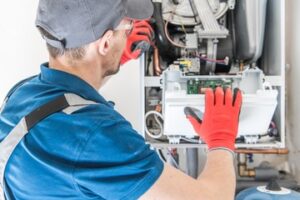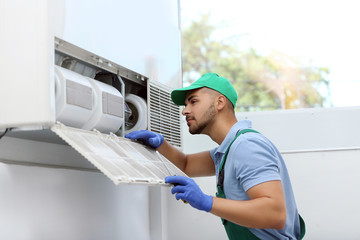CINCINNATI FURNACE REPAIR is essential for maintaining a comfortable and safe indoor environment. A malfunctioning furnace can lead to inconsistent heating and increased energy bills. Timely repairs help prevent costly breakdowns. Professional handling ensures efficient performance and longevity.
Furnaces rely on several components working together to generate heat. The burner, heat exchanger, and blower fan are key parts of the system. If one part fails, the entire system can lose efficiency. Identifying the root cause is crucial for effective repair.
Airflow problems are common in furnace systems. Clogged filters restrict airflow, reducing heating efficiency. Dust and debris buildup in ducts can also cause blockages. Cleaning and replacing filters regularly helps maintain consistent airflow.
The thermostat plays a vital role in regulating furnace operation. If the thermostat malfunctions, the furnace may cycle improperly. Incorrect temperature readings can cause overheating or inadequate heating. Calibrating the thermostat ensures accurate performance.
Ignition issues can prevent the furnace from starting. Faulty ignition switches or thermocouples often cause this problem. A weak pilot light or a broken ignition sensor can disrupt heating. Proper inspection and replacement resolve ignition failures.
Unusual noises often indicate mechanical problems. Grinding or banging sounds suggest worn-out bearings or loose parts. Rattling noises may point to unsecured panels or ducts. Addressing these issues early prevents further damage.
Gas leaks are a serious safety concern in furnaces. A distinct odor or hissing sound may signal a leak. Immediate shutdown and professional inspection are necessary. Proper sealing and connection repair eliminate the risk.
Heat exchanger cracks can reduce heating efficiency and pose safety risks. Carbon monoxide leaks are a potential danger. Visual inspection can reveal cracks or corrosion. Replacing a damaged heat exchanger restores safe operation.
Electrical problems can cause furnace failure. Loose wiring or tripped breakers interrupt power supply. Faulty relays and control boards affect system response. Professional testing identifies and resolves electrical faults.
Furnace blowers circulate heated air throughout the building. If the blower motor fails, air distribution weakens. Worn belts and fan blades reduce performance. Lubricating moving parts and replacing worn components ensure proper operation.
Short cycling occurs when the furnace turns on and off frequently. Overheating, clogged filters, or incorrect thermostat settings often cause this issue. Short cycling increases energy consumption and reduces system lifespan. Resolving airflow and thermostat problems restores stable operation.
Dirty burners reduce heating efficiency and cause uneven heating. Soot and debris buildup on burners restrict combustion. Regular cleaning maintains burner performance. Adjusting the burner flame ensures proper heat output.
Flame sensor failure can prevent the furnace from staying lit. Dirt and residue on the sensor disrupt the ignition process. Cleaning or replacing the sensor restores consistent ignition. Proper sensor function ensures reliable heating.
Vibration and shaking during furnace operation indicate mechanical imbalance. Loose mounting brackets or misaligned components are common causes. Tightening screws and securing parts reduce vibration. Balanced operation improves overall performance.
Carbon monoxide leaks from furnaces pose a health risk. Poor ventilation and cracked heat exchangers are common sources. Carbon monoxide detectors provide early warnings. Professional repair and sealing prevent dangerous leaks.
Frozen condensate lines can shut down high-efficiency furnaces. Blocked drainage can cause water backup and system failure. Thawing and clearing the lines restore proper drainage. Insulating the lines prevents future freezing.
Furnace filters should be replaced regularly to maintain airflow. Dirty filters reduce efficiency and increase strain on the blower motor. High-efficiency filters improve air quality. Consistent filter changes enhance furnace longevity.
Burner misalignment can cause uneven heating and wasted fuel. Improper burner positioning reduces combustion efficiency. Adjusting the burner ensures even heat distribution. Professional calibration maximizes energy use.
Pressure switches monitor airflow and combustion levels. Faulty switches can cause the furnace to shut down. Dirt and debris can interfere with switch function. Cleaning or replacing the switch restores accurate performance.
Furnace ducts should be inspected for leaks and damage. Gaps and cracks reduce heating efficiency. Sealing and insulating ducts improve heat retention. Proper ductwork enhances system performance.
Delayed ignition can cause loud bangs during startup. Gas buildup from incomplete combustion often causes this issue. Cleaning burners and adjusting ignition settings resolve the problem. Proper ignition timing prevents damage.
Furnace maintenance should include checking for gas pressure balance. Low pressure reduces heating output. High pressure can cause burner overheating. Adjusting the gas pressure ensures consistent heating.
Annual furnace inspections help detect potential issues early. Technicians check burner alignment, heat exchanger condition, and electrical connections. Early detection prevents costly repairs. Professional servicing extends furnace lifespan.
Zoning systems allow customized heating for different areas. Faulty zone valves or dampers reduce heating control. Repairing or replacing zone components restores balanced heating. Efficient zoning reduces energy waste.
Older furnaces often experience pilot light problems. Weak flames or frequent extinguishing are common signs. Cleaning the pilot assembly and adjusting the gas supply improve stability. Consistent pilot light operation ensures reliable heating.
Thermostat wiring issues can cause communication failures. Frayed or loose wires disrupt temperature regulation. Rewiring and securing connections resolve this problem. Proper wiring ensures accurate thermostat response.
Heat pump integration with furnaces improves efficiency. Faulty heat pump compressors reduce overall performance. Professional repair and recalibration restore compatibility. Balanced operation enhances energy savings.
Furnace air handlers distribute warm air through vents. Clogged or damaged handlers restrict airflow. Cleaning and repairing handlers improve heat distribution. Proper airflow maintains consistent indoor comfort.
Combustion chambers require regular cleaning and inspection. Soot buildup reduces heating efficiency. Cracks in the chamber can lead to gas leaks. Professional cleaning and sealing maintain safe combustion.
High-limit switches prevent furnace overheating. Malfunctioning switches cause premature shutdown. Dirt and debris interfere with switch function. Cleaning or replacing the switch restores proper operation.
Variable-speed blowers improve furnace efficiency. If the motor fails, airflow becomes inconsistent. Motor replacement or repair restores balanced operation. Proper blower function enhances heating control.
Air intake vents must remain clear for proper combustion. Blocked vents reduce air supply and efficiency. Removing obstructions restores airflow. Consistent air intake ensures stable furnace performance.
Furnace flame color indicates combustion health. A yellow or orange flame signals incomplete combustion. Adjusting the gas mixture and burner position corrects this issue. A blue flame indicates efficient combustion.
Delayed blower startup reduces heating efficiency. Faulty fan relays or control boards often cause this problem. Replacing damaged components restores proper response. Quick startup improves heat distribution.
Emergency furnace repairs require professional handling. Technicians assess system condition and safety risks. Immediate repairs prevent further damage. Professional service ensures long-term performance.
Homeowners can handle minor furnace issues with proper guidance. Resetting the thermostat, changing filters, and cleaning vents are manageable tasks. Complex repairs require professional expertise. Knowing when to call for help ensures safety and efficiency.
Furnace upgrades improve energy efficiency and comfort. Modern systems offer better fuel economy and programmable settings. Installing energy-efficient models reduces operational costs. Professional installation ensures optimal performance.
Furnace repair and maintenance protect indoor comfort and safety. Timely repairs prevent breakdowns and extend system lifespan. Professional handling ensures compliance with safety standards. Investing in furnace care enhances heating performance and reliability.


